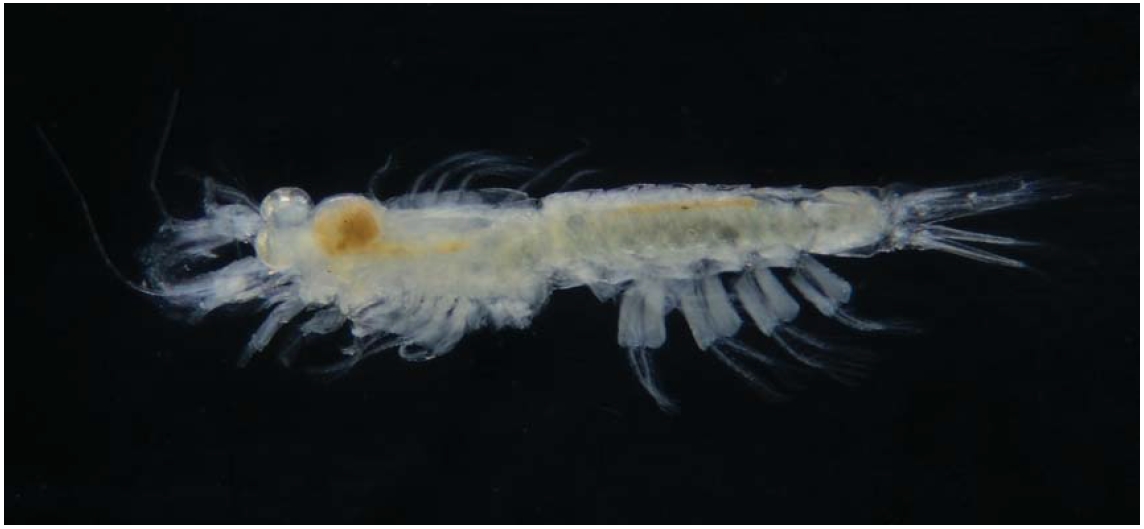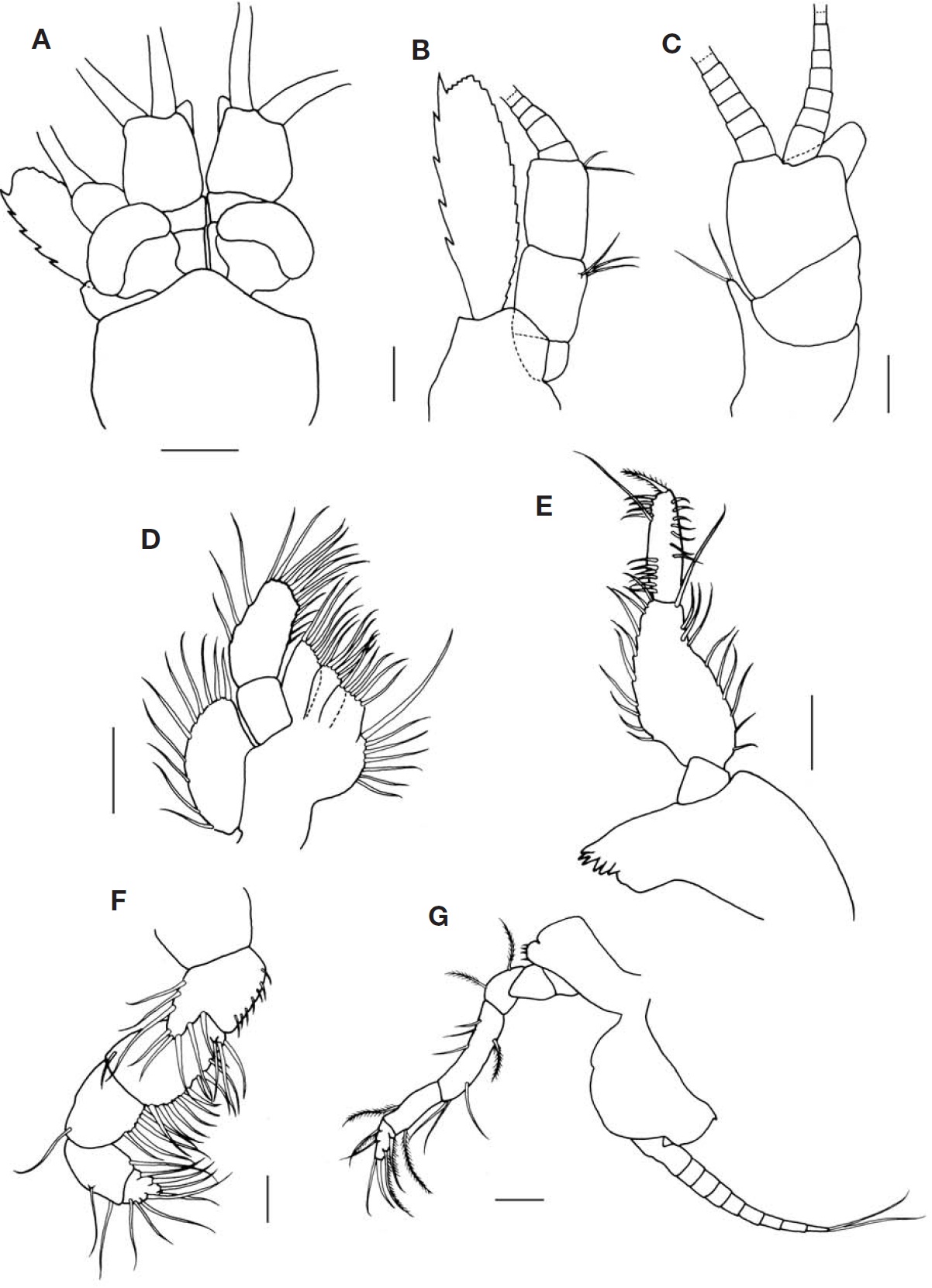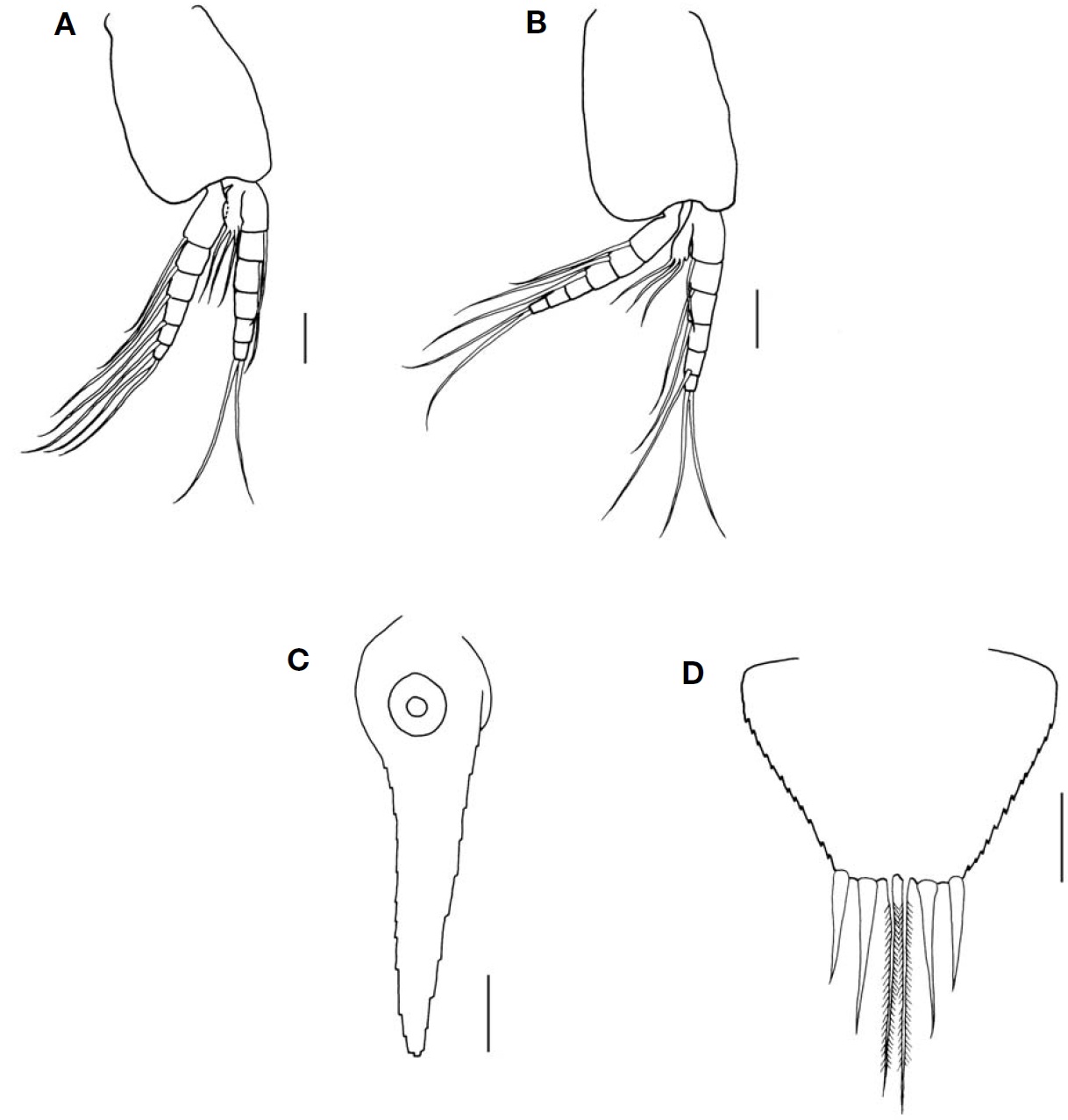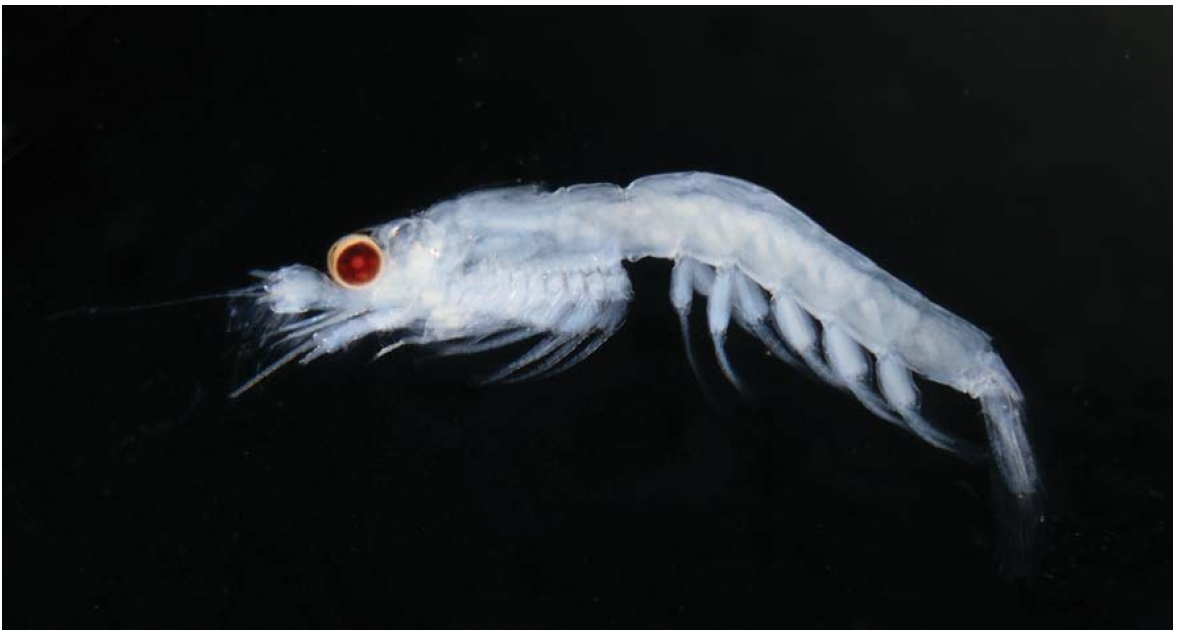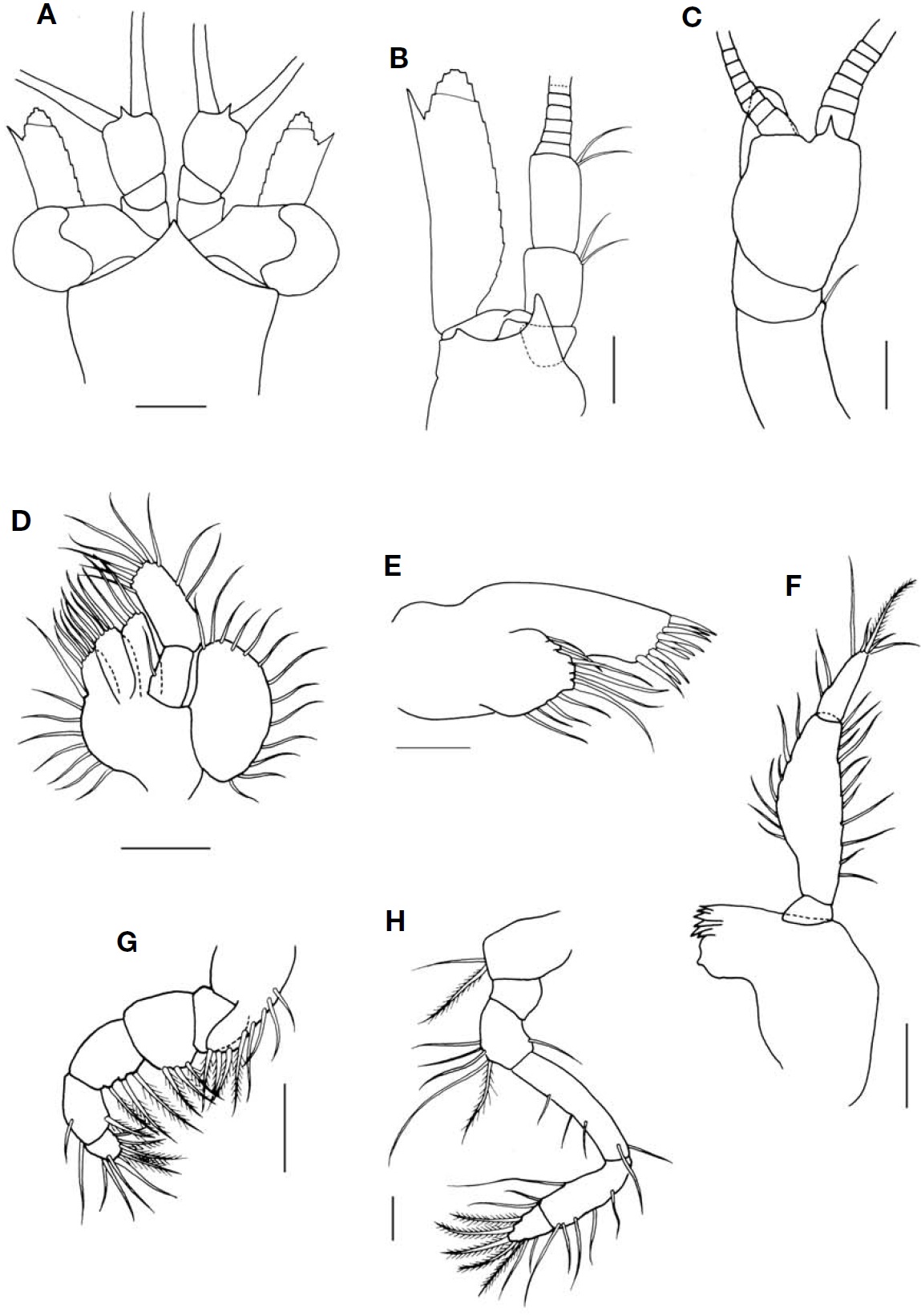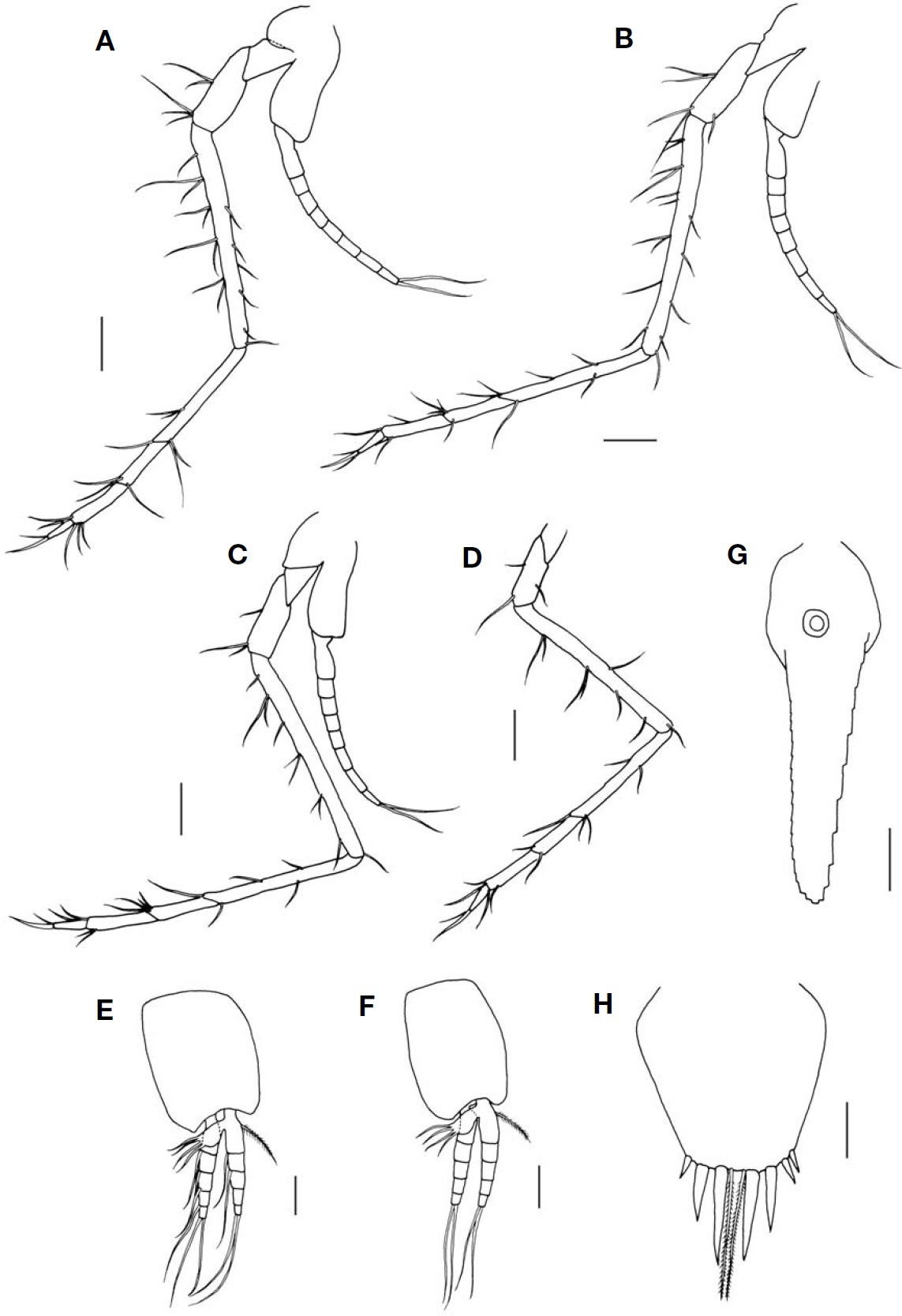



The tribe Erythropini Hansen, 1910 belonging to the sub-family Mysinae, is a peculiar group mainly found in the pelagic or deep sea (Ii, 1964). Although it consists of about 300 species of 50 genera worldwide, the fauna of Korean mysids is poorly known compared with that of other regions. So far only 4 species of 4 genera belonging to the tribe Ery-thropini have reported from Korea:
These species were collected from shallow waters by a light trap. Specimens were preserved in 70% ethyl alcohol and illustrations were drawn with the aid of compound micro-scope (Model BX-60; Olympus, Tokyo, Japan) fitted with a drawing tube. Images were recorded using a digital camera (Model D7000; Nikon, Tokyo, Japan), and produced with Helicon Focus software (Model Helicon Focus; Helicon Soft Ltd., Kharkov, Ukraine). Body length was measured from the tip of the rostrum to the distal apex of the telson exclud-ing the spine. The simple setae and plumage of the plumose setae on the margin of antennae, antennules, mouthparts, and uropods are omitted from the figures. Terminology for the dissection and measurement is after Tattersall and Tattersall (1951). All specimens have been deposited in the Marine Arthropod Depository Bank of Korea (MADBK), Seoul National University.
Order Mysida Haworth, 1825
Family Mysidae Dana, 1850
Subfamily Mysinae Haworth, 1825
Tribe Erythropini Hansen, 1910
1*Genus Erythrops G.O. Sars, 1869
2*Erythrops minuta Hansen, 1910 (Figs. 1-3)
Material examined. 2♂♂, Korea: Jeollabuk-do, Gunsan-si, 6 Jul 2006.
Description. Carapace (Fig. 2A) with anterior margin pro-duced into low triangular rostral plate with blunted tip, reach-ing base of first segment of antennular peduncle; posterior margin emarginated, antero-lateral corners rounded form.
Eye (Figs. 1, 2A) rather small, reaching end of second seg-ment of antennular peduncle; cornea reniform, occupying half of whole eye; eyestalk without denticles.
Antennal scale (Fig. 2B) lanceolate with round apex, about 3.5-4 times as long as broad; distal suture scarcely develop-ed; inner margin convex with setae; outer margin slightly convex without setae, bearing terminal one strong spine and 4 additional stout spines which arranged at almost equal in-tervals along margin. Antennal peduncle (Fig. 2B) 3-seg-mented; first segment unarmed; second one with 3 simple setae on distal margin; third one with 2 simple setae on distal margin, subequal to first.
Antennular peduncle (Fig. 2C) 3-segmented; first segment subequal to third in length, with well developed processus masculinus covered in hirsute hair (hair omitted in figure); second and third segments unarmed.
Mandibular palp (Fig. 2E) 3-segmented; second segment slightly swollen, 1.5 times as long as third.
Maxilla, and endopod of first and second thoracopods (Fig. 2D, F, G) showing no marked difference from those in other species.
Endopod of third to eighth thoracopods all broken and ex-tremely damaged due to bad condition of specimens.
Pleopod of male (Fig. 3A, B) well developed and biramous; both endopod and exopod 6-segmented and subequal in length.
Inner uropod (Fig. 3C) without spines in ventral statocyst region; outer uropod 1.2 times longer than inner one.
Telson (Fig. 3D) broadly distinct trapezoidal form; lateral margin of proximal 1/4 naked, remaining region armed with several serrulates closely; apex broadly truncated, 2/5 length of base, bearing 2 pairs of stout spines and 1 pair of secon-dary plumose setae; inner ones 1.5 times longer than outer ones and secondary plumose setae very long, almost twice as long as outermost spines.
Distribution. Korea (present study), Japan, Malaysia, Thai-land, Singapore, and Taiwan.
Remarks. Two present specimens agree well with Hansen’s (1910) original description of
1*Erythrops nana W. Tattersall, 1922 (Figs. 4-6)
Material examined. 1♂, Korea: Gyeongsangnam-do: Tong-yeong-si, Yokji-myeon, Isl. Yokjido, 8 Dec 2010, in light trap; 3♂♂, 1♀, Nodae-ri, Isl. Sangnodaedo, 31 Aug 2011, in light trap.
Description. Carapace (Fig. 5A) with anterior margin pro-duced into triangular rostral plate with pointed tip, reaching half of first segment of antennular peduncle; posterior mar-gin emarginated, antero-lateral corners pointed form.
Eye (Figs. 4, 5A) normal, cornea distinct reniform in dor-
sal view, occupying 1/3 of whole eye; eyestalk elongated without denticles.
Antennal scale (Fig. 5B) lanceolate with round apex, about 4 times as long as broad; distal suture occupying 1/11 of whole length; inner margin nearly straight with setae; outer margin slightly concave, without setae, and terminating one strong spine. Antennal peduncle (Fig. 5B) 3-segmented; second segment with 2 simple setae on distal margin, twice as long as first; third segment longest, with 2 simple setae on distal margin.
Antennular peduncle (Fig. 5C) 3-segmented; first segment equal to third in length, about 2 times as long as second one, with large processus masculinus covered in hirsute hair (hair omitted in figure).
Maxilla (Fig. 5D) armed with plumose setae along margin; endopod 2-segmented, second segment about 1.7 times as long as broad; exopod broad and round in shape.
Maxillule, mandible (Fig. 5E, F), and endopod of first and second thoracopods (Fig. 5G, H) showing no remarkable characteristics.
Endopod of third to eighth thoracopods (Fig. 6A-D) with 3-subsegmented carpopropodus; proximal segment of carpo-propodus longest, distal articulation distinctly oblique, re-maining two segments half as long as first one, dactylus slen-der; basal plate of exopod of thoracopods narrow without spinules.
Pleopod of male (Fig. 6E, F) well developed, biramous; both endopod and exopod 5-segmented and subequal in length.
Inner uropod (Fig. 6G) without spines in ventral statocyst region; outer uropod 1.2 times longer than inner one.
Telson (Fig. 6H) broadly trapezoidal form; lateral margin of proximal 1/5 point strongly convex, naked as whole; apex broadly truncated, usually armed with 3 pairs of stout spines and 1 pair of secondary plumose setae, occasionally extra outermost spine in one side; innermost spines half as long as telson, subsequent pair of spines 2/3 length than inner ones, and outermost spines especially very short, less half as long as medium spines; secondary plumose setae very long, twice as long as medium spines.
Distribution. Korea (present study), Japan, and Andaman Island (Indian Ocean).
Remarks.
Korean name: 1*짧은꼬리곤쟁이속 (신칭), 2*톱니가시곤쟁이 (신칭)
Korean name: 1*짧은꼬리곤쟁이 (신칭)
